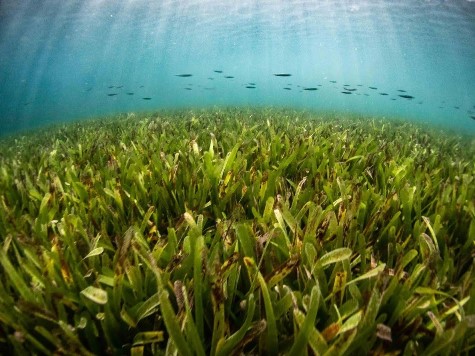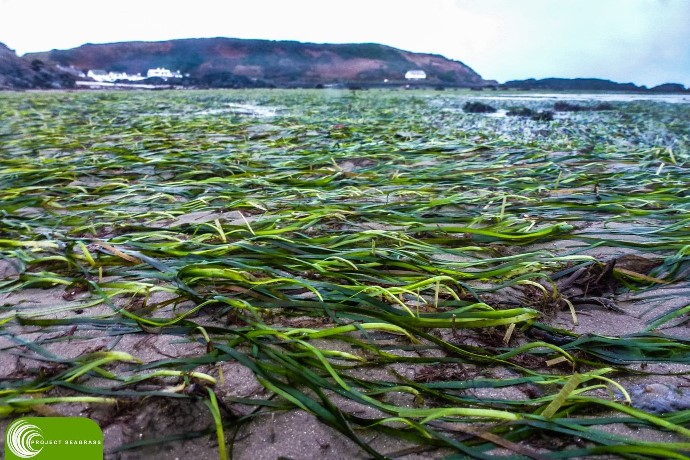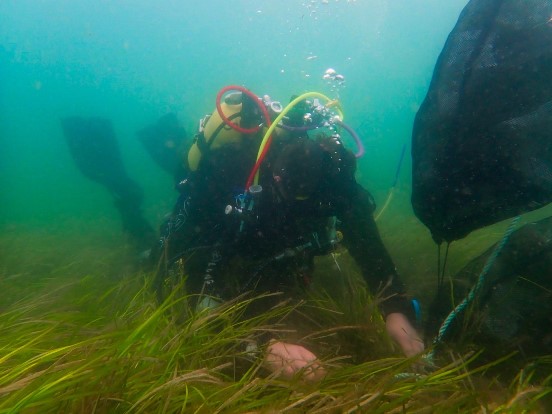The importance of saving the worlds seagrass
This post is greater than 6 months old - links may be broken or out of date. Proceed with caution!

By Bethan Thomas, Communications and Engagement Lead

If you’ve never heard of seagrass, you’re not alone. It is the hidden wonder of the marine world. A plant that moved from land to sea and adapted to life underwater in the shallow, sheltered areas of our ocean. Like plants on land, seagrass has roots, shoots, and even produces flowers and seeds. It is these qualities that make seagrasses so unique. Their roots extend into the sediment to stabilise the seabed and reduce coastal erosion. Their shoots grow towards the light and slow down the force of the sea making our waters clearer. Seagrasses form a complex ecosystem that offers shelter for many diverse marine species. They also draw in vast quantities of carbon and can lock this away in their sediment for thousands of years.

Seagrasses come in a variety of shapes and sizes. From long, slender shoots that resemble spaghetti to fern or paddle-shaped leaves, there are over 70 species found across the globe on every continent except Antarctica. This diversity makes seagrass important for a wide array of marine species. For example, the species Thalassia testidium is better known by its common name turtlegrass as it is a vital food source for green turtles who feed upon the leaves. In the UK, we have two species of seagrass: Zostera marina, also known as eelgrass, and Zostera noltii also known as dwarf eelgrass. Dwarf eelgrass tends to be found in the intertidal zone of beaches and so is often uncovered when the tide goes out. Eelgrass can also be found on the beach at low tide but may also grow underwater up to 10m in depth.
However, despite the numerous benefits seagrasses provide to people and planet, we are losing seagrass across the world at an unprecedented rate. It is estimated that we lose approximately 2 football fields worth of seagrass every single hour. Coastal development, damaging fishing practices, overexploitation and poor water quality are among the most dominant factors contributing to the widespread loss. Recovery from damage is often a slow process and depends upon the species of seagrass damaged, the extent of the damage and the sediment type. Water quality plays a large role in both decline and recovery. Its decline is comparable to other, perhaps more popular ecosystems and yet the plight of seagrass tends to go under the radar.

Project Seagrass is the only global environmental charity solely dedicated to the conservation of seagrass ecosystems to ensure they are protected now and for future generations. The charity was formed in 2013 by a small team of passionate scientists who recognised a need to increase awareness about this important habitat. We have since grown from a Twitter profile sharing seagrass facts to a globally renowned organisation leading some of the largest seagrass restoration projects in the UK. Our work rests on three pillars: community, research, and action. It is through these three pillars that we work towards our vision: “a world in which seagrass meadows are thriving, abundant and well managed for people and planet”.
This year, communities will come together to celebrate seagrasses across the globe. Thanks to a Sri Lanka sponsored resolution to the United Nations General Assembly, March 1st is now declared ‘World Seagrass Day’ and 2023 is the first year the importance of seagrasses will be formally recognised on this day. This is an opportunity to celebrate the vital habitat seagrasses create and raise awareness of the threats it faces. And because just one day isn’t enough, we will also be celebrating Seagrass Awareness Month throughout the month of March so there will be plenty of opportunities to shout about seagrass and get involved with the celebrations. As well as all of this, this year celebrates Project Seagrass’ 10th anniversary on 29th July. It has been a wonderful ten years of championing seagrass and we will be sure to make a splash.

Our goal is to make seagrass a familiar habitat to everyone, so it is no longer overlooked but given the attention it deserves. Get involved with Project Seagrass this World Seagrass Day by spreading the word, attending one of our events or by going out and spotting seagrass with SeagrassSpotter. SeagrassSpotter is our citizen science programme designed to improve seagrass conservation with global observations. With SeagrassSpotter, anyone can contribute to marine conservation with just a few taps of their phone. If you’re out for a walk along the coast, heading out snorkelling or going for a dive and you happen across some seagrass, you can take a quick photo and upload it to SeagrassSpotter. Every upload contributes to creating a comprehensive picture of seagrass meadows across the globe to inspire practical conservation efforts that we can use to help protect these meadows. You can use the app or upload existing photos through SeagrassSpotter.org. In the meantime, make sure to pop 1st March 2023 in your diaries! See you there.
Find more at http://projectseagrass.org/ & http://seagrassspotter.org/
More from Project Seagrass